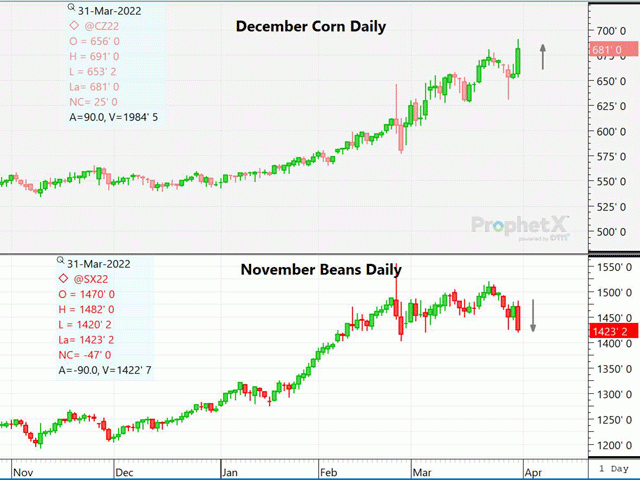USDA Reports Review
Corn Futures Rise, Soybean Futures Fall Following USDA Seedings Surprise
USDA's March 1 quarterly Grain Stocks and Prospective Planting reports began the day with few, if any, traders expecting a big surprise. That turned out to be wrong, with the final seeding numbers for corn and soybeans changing by nearly a one-for-one basis. The net effect was bullish for corn and bearish for soybeans.
Let's take a look at some of the numbers:
CORN
With few traders expecting any major divergence from the average trade estimate for corn seedings, which happened to match the USDA's February Outlook Forum estimate of 92 million acres, USDA threw a curveball. Acreage intentions were reported to be just 89.5 million acres, the lowest in five years, 2.5 ma under the Dow Jones estimate, and a huge 3.9 ma below last year's seedings.
Despite a soybean-corn ratio that began the day at a low 2.24 to 1, which would typically favor corn, farmers opted for more beans in the survey. One would have to guess that the culprit was surely not price but had to be the sharply elevated input costs for corn versus beans. Illinois, Indiana and Iowa came in at 300,000 fewer acres, while North Dakota intends to seed about a half-million fewer acres than a year ago. December corn, trading 2 cents lower prior to the report at one point, was up 38 cents on the day and closed nearly 28 cents higher.
Moving on to the March 1 stocks number for corn, the trade had expected 7.885 billion bushels (bb), but the final number was 35 million bushels (mb) lower than that, at 7.850 bb. That was 154 mb higher than a year ago. So, the combination of slightly lower corn stocks coupled with the sharp fall in intended seedings sent the corn market flying to a new contract high on December, at $6.91, finishing up nearly 28 cents.
P[L1] D[0x0] M[300x250] OOP[F] ADUNIT[] T[]
Of the stocks total, 4.08 bb was still on farm, with 3.77 bb in off-farm positions. December-through-February disappearance figured 3.79 bb, up from 3.6 bb a year ago.
SOYBEANS
For the second part of the acreage intentions surprise, soybean acres were reported at a much-higher-than-expected 91 million acres, which, if it comes to fruition, would be record large. The 91 ma compared to the pre-report Dow Jones estimate of just 88.8 ma and last year's 87.2 ma -- up a whopping 3.8 million acres -- nearly the polar opposite of corn. Indiana, Iowa and Illinois were estimated to be seeding from 250,000 to 400,000 acres more. November beans would end up closing 49 3/4 cents lower, while December corn moved up 27 3/4 cents.
As if that weren't enough bearish news for soybean longs, the March 1 stocks number of 1.931 bb figured 38 million bushels above the average trade guess and up 369 mb versus a year ago. There's no doubt that the slow pace of soybean exports contributed to this bearish number.
Of the total, on-farm soybeans totaled 750,000 mb and up 26% versus last year, while soybeans off farm totaled 1.18 bb, up 22%. Disappearance for December-February came in at 1.22 bb and down 12% versus last year.
New-crop November soybeans took the bearish seeding number and ran with it, as longs tried to exit, with November beans finishing nearly 50 cents lower for the day, perhaps influencing some of those intentions.
WHEAT
The all-wheat acreage intentions number came in slightly lower than expected at 47.4 ma, with the trade expecting 47.8 ma. That was up from 46.7 ma a year ago, so 700,000 acres more. Buried in that total was intentions of 34.2 ma of winter wheat -- about 200,000 acres fewer than expected, and 11.2 ma of spring wheat -- down 500,000 from expectations. Winter wheat is up 600,000 acres from last year, with spring wheat acres down nearly 200,000 acres, sending Minneapolis to a strong close, while Chicago and Kansas City rebuffed higher prices, finishing lower. A fall of 500,000 acres in hard red spring wheat was a bit of a surprise and was likely due to soybeans. Durum wheat intentions were about 20,000 acres more than the trade estimated, at 1.92 ma, and up 17% from last year.
In the March 1 wheat stocks column, there was a minor surprise, with wheat stocks of 1.025 bb, down 39 mb from trade expectations and down a sizable 286 mb from a year ago. That figures to be the lowest March 1 wheat stocks in 14 years. That was a surprise, with U.S. wheat exports in the doldrums and is likely due to additional feeding. The bullish euphoria from the stocks number was short-lived, as both Chicago and Kansas City wheat finished the day 60 to 70 cents below the daily wheat highs and lower for the day.
SOME FINAL THOUGHTS
While the distribution of intended acreage was certainly a shock to corn and soybean traders, the total acreage intentions for the two was nearly identical to last year, at 180.5 million acres. One would have thought that with prices where they have been so far this year and with the loss of corn and wheat bushels from Ukraine, at least temporarily, we might see even higher intentions, but there is only so much land to be had.
The sharp divergence between corn and soybeans can only be explained by the rising cost of crop inputs, especially fertilizer and fuel. However, a lot can change in the next several weeks, and final acreage could be far different. Now, we will likely go back to trading weather and the daily, and volatile, news headlines from the Russia-Ukraine conflict.
Dana Mantini can be reached at Dana.Mantini@DTN.com
(c) Copyright 2022 DTN, LLC. All rights reserved.






